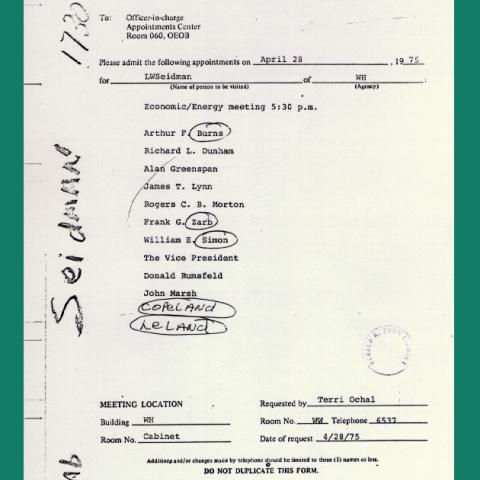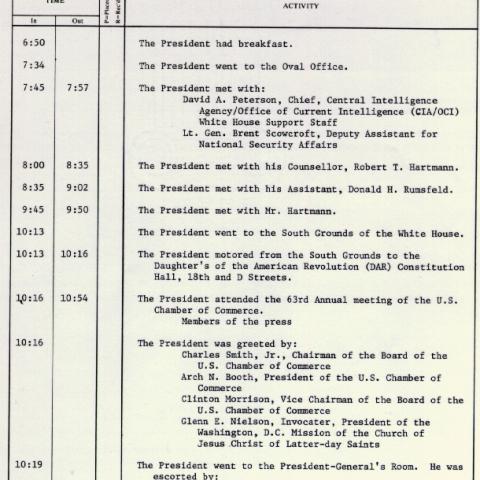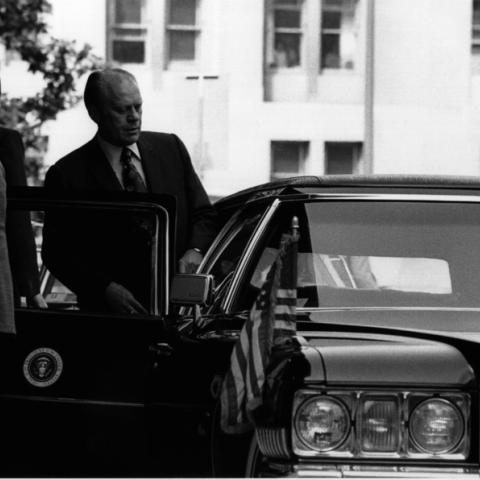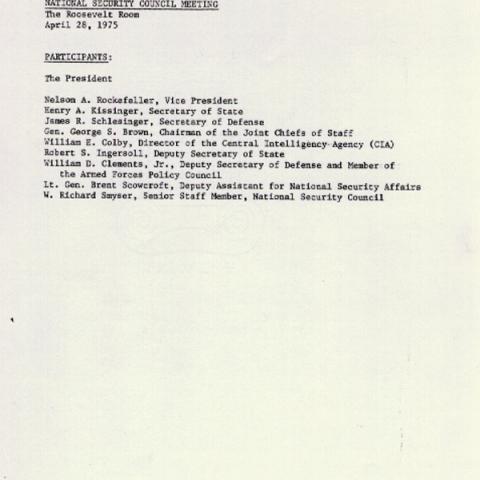This exhibit allows the viewer to examine the daily diary (a log of the President Gerald R. Ford's meetings and activities) for April 28, 1975. By selecting links from certain activities, you can view documentation (documents, photographs, and even a short video clip) on them.
Among other events on that day, the President spoke to the U.S. Chamber of Commerce on regulatory reform, ordered the evacuation of the last Americans from South Vietnam, and posed for photographs with the 1974-75 Miss National Teenager.
Diary April 28, 1975
Gallery of activities April 28, 1975
Sequence
| Time (In-Out) | Activity |
|---|---|
| 6:50 | The President had breakfast. |
| 7:34 | The President went to the Oval Office. |
| 7:45-7:57 | The President met with: David A. Peterson, Chief, Central Intelligence Agency/Office of Current Intelligence (CIA/OCI) White House Support Staff Lt. Gen. Brent Scowcroft, Deputy Assistant for National Security Affairs |
| 8:00-8:35 | The President met with his Counsellor, Robert T. Hartmann. |
| 8:35-9:02 | The President met with his Assistant, Donald H. Rumsfeld. |
| 9:45-9:50 | The President met with Mr. Hartmann. |
| 10:13 | The President went to the South Grounds of the White House. |
| 10:13-10:16 | The President motored from the South Grounds to the Daughter's of the American Revolution (DAR) Constitution Hall, 18th and D Streets. |
| 10:13-10:16 | The President attended the 63rd Annual meeting of the U.S. Chamber of Commerce. Members of the press |
| 10:16 | The President was greeted by: Charles Smith, Jr., Chairman of the Board of the U.S. Chamber of Commerce Arch N. Booth, President of the U.S. Chamber of Commerce Clinton Morrison, Vice Chairman of the Board of the U.S. Chamber of Commerce Glenn E. Nielson, Invocater, President of the Washington, D.C. Mission of the Church of Jesus Christ of Latter-day Saints |
| 10:19 | The President went to the President-General's Room. He was escorted by: Mr. Smith Mr. Booth Mr. Morrison Mr. Nielson |
| 10:20 | The President, escorted by Mr. Smith, went to an offstage announcement area. |
| 10:21 | The President, escorted by Mr. Smith, went to the platform. The President was introduced by Mr. Smith. For a list of platform guests, see APPENDIX A |
| 10:23 - 10:40 | The President addressed approximately 3,000 members of affiliated Chambers of Commerce attending the meeting. Members of the press |
| 10:54 | The President, escorted by Mr. Smith, returned to his motorcade. |
| 10:54-10:55 | The President motored from the DAR Constitution Hall to the South Grounds of the White House. |
| 10:57 | The President returned to the Oval Office. |
| 11:00-11:40 | The President met with: Mr. Hartmann John O. Marsh, Jr., Counsellor Mr. Rumsfeld Max L. Friedersdorf, Assistant for Legislative Affairs Ronald H. Nessen, Press Secretary |
| 11:43-12:45 | The President met with: Henry A. Kissinger, Secretary of State |
| 11:50-12:45 | The President met with: Lt. Gen. Scowcroft |
| 12:45-1:05 | The President met with Mr. Marsh. |
| 1:05-1:20 | The President met to discuss federal aid to parochial schools with: Monsignor Herman H. Zerfas, Superintendent of Education, Diocese of Grand Rapids, Michigan Ival E. Zylstra, Administrator, School and Governmental Relations, National Union of Christian Schools, Grand Rapids, Michigan James M. Cannon III, Executive Director of the Domestic Council and Assistant for Domestic Affairs |
| 2:03-2:26 | The President met with Secretary of Health, Education, and Welfare (HEW) Caspar W. Weinberger. |
| 2:30-3:16 | The President met with: Mr. Rumsfeld Richard B. Cheney, Deputy Assistant |
| 3:50-3:56 | The President participated in the swearing-in ceremony of John Dellenback as Associate Director of International Operations, ACTION. For a list of attendees, see APPENDIX B. |
| 4:05-4:35 | The President met with: Mr. Rumsfeld Mr. Cheney |
| 4:40-5:19 | The President met with: Governor James E. Holshouser (R-North Carolina) Mr. Hartmann Mr. Rumsfeld |
| 5:20-5:25 | The President met with: Congressman Richard Kelly (R-Florida) Lisa Lyon, 1974-75 Miss National Teenager Mrs. E.G. Shaeffer, Miss National Teenager Pageant Director Charles Leppert, Jr., Special Assistant for Legislative Affairs |
| 5:26-5:27 | The President talked with Secretary Kissinger. [phone call received] |
| 5:27-5:43 | The President met with: William T. Coleman, Jr., Secretary of Transportation Mr. Cheney William N. Walker, Director of the Presidential Personnel Office and Deputy Special Representative-designate for Trade Negotiations |
| 5:47 | The President went to the Cabinet Room. |
| 5:47-7:12 | The President attended a meeting to discuss the economy and energy. For a list of attendees, see APPENDIX C. |
| 7:12 | The President, accompanied by Vice President Nelson A. Rockefeller, returned to the Oval Office. |
| 7:12-7:23 | The President met with: Vice President Rockefeller. |
| 7:15-7:23 | The President met with: Secretary Kissinger. |
| 7:23 | The President went to the Roosevelt Room. He was accompanied by: Vice President Rockefeller Secretary Kissinger |
| The President participated in a National Security Council (NSC) meeting. For a list of attendees, see APPENDIX D. | |
| 8:08 | The President returned to the Oval Office. |
| 8:19 | The President returned to the second floor Residence. |
| 8:30-8:43 | The President met with: Secretary Kissinger |
| 8:34-8:43 | The President met with: Lt. Gen. Scowcroft |
| 9:06-9:11 | The President talked with Mr. Rumsfeld. [phone call received] |
| 9:15 | The President and the First Lady had dinner. |
| 10:24-10:32 | The President talked with Secretary Kissinger [phone call received] |
| 10:33-10:37 | The President talked with Secretary of Defense James R. Schlesinger. [phone call received] |
| 10:47-10:50 | The President talked with Secretary Kissinger. [phone call received] |
| 11:22-11:23 | The President talked with the U.S. Secret Service Agent stationed at the Residence stairway. [phone call placed] |
| 11:28 | The President returned to the Oval Office. |
| 11:28-12:05 | A record of the President's meetings during this time period was not available for inclusion in the President's diary. |
| 11:28 | The President was telephoned by Secretary Kissinger. The call was not completed. [phone call received] |
| 11:31 | The President went to the Situation Room. |
| 12:05 | The President returned to the second floor Residence. |
Meetings and activities
The white house
Washington
63rd annual meeting of the u. S. Chamber of commerce
Constitution Hall
MONDAY - APRIL 28, 1975
Departure- 10:10 a. m.
From: Terry O ' Donnell
BACKGROUND
Arch Booth, President of the U. S. Chamber of Commerce, invited you to address the 63rd Annual Meeting. The theme of the meeting will be the critical choices facing America. Approximately 3,000 members of affiliated Chambers will attend the First General Session.
SEQUENCE
| Time | Activities |
|---|---|
| 10:10 a. m. | Board motorcade on South Grounds and depart en route Constitution Hall. |
| 10:15 a. m. | Arrive Constitution Hall where you will be met by Charles Smith, Jr., Chairman of the Board, U.S. Chamber of Commerce; Arch Booth, President; Clinton Morrison, Vice Chairman of the Board; and Glen Nielson, Invocater.PRESS POOL COVERAGEEscorted by Charles Smith, Arch Booth, Clinton Morrison, and Glen Nielson, proceed to the President-General's Room. |
| 10:16 a. m. | Arrive President-General's Room (Holding Room).OFFICIAL PHOTO COVERAGE |
| 10:19 a. m. | Escorted by Charles Smith, depart President-General's Room en route off-stage announcement area. |
| 10:20 a. m. | Arrive off-stage announcement area and pause for announcement. |
| 10:20 a. m. | "Ruffles and Flourishes" Announcement "Hail to the Chief" |
| 10:21 a. m. | Escorted by Charles Smith, proceed to stage and take your seat. OPEN PRESS COVERAGE ATTENDANCE: 3,000 |
| 10:22 a. m. | Introduction of you by Charles Smith. |
| 10:23 a. m. | PRESIDENTIAL REMARKSFULL PRESS COVERAGE |
| 10:40 a. m. | Remarks conclude. Charles Smith joins you at podium and thanks you. |
| 10:43 a. m. | Escorted by Charles Smith, depart stage en route motorcade, board, and depart Constitution Hall en route South Grounds. |
| 10:55 a. m. | Arrive South Grounds of the White House. |
Gallery
Transcription
APPENDIX A
63RD ANNUAL MEETING OF THE U. S. CHAMBER OF COMMERCE
DAR Constitution Hall
April 28, 1975
A list of platform guests attending the conference was not available for inclusion in the President's diary.
APPENDIX B
SWEARING-IN CEREMONY FOR JOHN DELLENBACK
confirmed by EPS
The Oval Office
April 28, 1975
PARTICIPANTS:
- The President
- John Dellenback, Associate Director of International Operations, ACTION
- Mrs. John Dellenback (Mary Jane)
- Richard Dellenback, son
- David Dellenback, son
- Senator Mark O. Hatfield, (R-Oregon)
- Mrs. Mark O. Hatfield (Antionette)
- Mrs. Coleen Evans, wife of Minister of National Presbyterian Church
- Jack Ganley, Deputy Director, ACTION
- Alfredo Pereg, Regional Director, Latin America Regional Office, ACTION
- Fred Hansen, ACTION
- Judge Oliver Gasch, U.S. District Judge for the District of Columbia
APPENDIX C
ECONOMIC/ENERGY MEETING
Confirmed by T. Ochal The Cabinet Room
April 28, 1975
PARTICIPANTS:
- The President
- Nelson A. Rockefeller, Vice President
- L. William Seidman, Executive Director of the Economic Policy Board and Assistant for Economic Affairs
- William E. Simon, Secretary of the Treasury
- Rogers C.B. Morton, Secretary of Commerce
- James T. Lynn, Director of the Office of Management and Budget (OMB) and Assistant for Management and Budget
- Arthur F. Burns, Chairman of the Board of Governors of the Federal Reserve System
- Max L. Friedersdorf, Assistant for Legislative Affairs
- John O. Marsh, Jr., Counsellor
- Richard B. Cheney, Deputy Assistant
- Ronald H. Nessen, Press Secretary
- James M. Cannon III, Executive Director of the Domestic Council and Assistant for Domestic Affairs
- Richard L. Dunham, Deputy Director of the Domestic Council
- Lt. Gen. Brent Scowcroft, Deputy Assistant for National Security Affairs
- Robert T. Hartmann, Counsellor
- John A. Hill, Deputy Administrator of the Federal Energy Administration (FEA)
- Eric R. Zausner, Assistant Administrator for FEA
- James E. Connor, Cabinet Secretary
- Robert Hormats, Deputy For International Economic Affairs, National Security Council
APPENDIX D
NATIONAL SECURITY COUNCIL MEETING
confirmed by Jeannie Davis (NSC)
The Roosevelt Room
April 28, 1975
PARTICIPANTS:
- The President
- Nelson A. Rockefeller, Vice President
- Henry A. Kissinger, Secretary of State
- James R. Schlesinger, Secretary of Defense
- Gen. George S. Brown, Chairman of the Joint Chiefs of Staff
- William E. Colby, Director of the Central Intelligency-Agency (CIA)
- Robert S. Ingersoll, Deputy Secretary of State
- William D. Clements, Jr., Deputy Secretary of Defense and Member of the Armed Forces Policy Council
- Lt. Gen. Brent Scowcroft, Deputy Assistant for National Security Affairs
- W. Richard Smyser, Senior Staff Member, National Security Council
Meeting Agenda
The White House Washington
April 26, 1975
Economic and Energy Meeting
April 28, 1975
5:30 p.m.
Cabinet Room
From: L. William Seidman
PURPOSE
To review energy program alternatives.
BACKGROUND, PARTICIPANTS AND PRESS PLAN
Background: The Weekly Economic Fact Sheet is attached at Tab A. The Economic Policy Board Weekly Report is attached at Tab B. This meeting is to report on the outcome of the energy negotiations with the Congress and to consider energy program alternatives. An options paper on the energy program alternatives is attached at Tab C.
Participants: The Vice President, William E. Simon, L. William Seidman, Rogers C.B. Morton, Frank G. Zarb, James T. Lynn, Alan Greenspan, Arthur F. Burns, Richard Dunham, Donald Rumsfeld, John O. Marsh.
Press Plan: White House Press Corps Photo Opportunity.
AGENDA
Energy Program Alternatives: Rogers Morton and Frank Zarb will review the recent negotiations with Congress on the energy program and alternatives for May 1 decisions on energy.
The President's Talking Points
Presidential Talking Points for the 5:30 Meeting on May 1 Energy Action
1. Rog Morton, I understand that Frank [Zarb] and others have been working around the clock with the Congress to reach some compromises on our energy program. Before discussing the options paper I think Frank should bring us up to date on these discussions.
2. Would anyone else like to add their views on the current situation?
3. Frank, why don't you go over the options in the paper and generally describe the advantages and disadvantages of each?
Executive Protective Service Log of Meeting Attendeees

Contextual Information
This is an excerpt from Gerald R. Ford, A Time To Heal: The Autobiography of Gerald R. Ford, New York: Harper & Row Publishers, 1979, page 256:
The final siege of Saigon began on April 25. Kissinger was on the telephone to U.S. Ambassador Graham Martin several times a day, and his reports convinced me that the country was going to collapse momentarily. In the late afternoon of April 28, I was chairing a meeting of my economic and energy advisers in the Cabinet Room when Brent Scowcroft entered and handed me a note. A message had just come in to the Situation Room downstairs. Our Air Force, it said, had been forced to halt evacuation flights from Saigon because Communist rockets and artillery shells were blasting the runways at Tan Son Nhut. A C-130 transport plane had been destroyed and several U.S. Marines killed. Nearly a thousand Americans still remained in Saigon, and we had to carry out our plans to evacuate them.
Leaving the Cabinet Room, I stepped into the Oval Office and discussed the crisis with Kissinger and Rockefeller. Then I convened a meeting of the NSC in the Roosevelt Room. It was 7:30 P.M. in Washington, almost dawn in Saigon.
** DECLASSIFIED **
SECRET/SENSITIVE 28 12:15 APRIL 1975 VIA MARTIN CHANNEL
SAIGON 0757 IMMEDIATE
DELIVER IMMEDIATELY
APRIL 28, 1975
TO: HENRY A. KISSINGER
FROM: AMBASSADOR GRAHAM MARTIN
REF: WH 50768
- It seems to me your views in reftel again assure the "worst case" development, and the time frame is far more rapid than one should expect in Asia.
- I still think they will opt to follow the scenario (their interpretation, of course) laid down in the Paris Agreements. There is a curious compulsion to prove they have fully intended to comply all along.
- Minh and Vu Van Mau who will be his Prime Minister and Foreign Minister are thinking of quickly recognizing the "PRG" as a legitimate government. If this occurs, we will have the reality of three Viet-Nams - DRV, PRG, RVN.
- The immediate task is the negotiation of a "cease-fire". This will cause enormous pressure to do away with the American military presence, and to emasculate the RVNAF into an ineffective force. Minh seems to recognize that both are bargaining chips, at least the speed with which he agrees to do this may become so. Both these are being rapidly accomplished, the first by our rapid drawdown, the second by the lack of prospect for future military aid, and the rapid departure of many senior officers. Today, Hanoi's domestic service in Vietnamese said that: QUOTE Yesterday, 27 April, the U. S. Defense Attache Office in Saigon announced that it would close in 36 hours, putting an end to the system of U. S. military advisers which has lasted for as long as 25 years in South Viet-Nam. UNQUOTE
- After the cease-fire and area delimitation can come the formation of the NCNRC. My guess is that it will take at least three months to get to this point. My further guess is that it will not necessarily be a "two/thirds communist". I would expect more a 60-40 lineup in some months with the 40 percent or even less on the communist side. They are simply not in that much of a hurry.
- The first concentration is going to be on formation of local administrations that can begin to get the countryside under control. After all this is accomplished - a year or more - they may begin to tighten the screws on the administration of Saigon. Even here, I would judge, they will wish to show a gentle face for a while.
- Now all this provides time. The new administration will be counting on us, I think, to help them buy a little more time. The withdrawal of our presence in an immediate or precipitate way would almost certainly finally pull out the rug.
- Where does the U. S. interest lie? My own emotional inclination is to close down. But I don't really think that course will really serve U. S. national interests as well as playing it cool for a while longer. While this is not true, it saves face for Hanoi and permits them to permit a more slow liquidation by announcing it has already taken place.
- Phong, the GVN negotiator in Paris, said today he had received by telex from Paris the following four conditions from the PRG:
- The GVN must be entirely of new composition. There must be no holdovers.
- Policy of new government must be one of reconciliation and concord.
- All American military personnel, or those camouflaged as military personnel, must be removed from country.
- All "political prisoners" must be released and civil liberties restored.
- The first two and the fourth are easy. We are helping them achieve the third before it can be a bargaining lever.
- So there should be little ban to commencement of serious negotiations. The French apparently agree with you that Paris is the preferred spot. The first item after the cease-fire may well be delimitation of areas. It would not surprise me to see a Nha Trang-Dalat-Tay Ninh line, although they may well be more harsh in their terms.
- One important point to remember is that the way the transition was managed leaves us no sticky problem of recognition. There has been only a change in the Chief of State. We have no more technical, legal problem than when Huong succeeded Thieu. Even Nhan Dan this morning referred to Minh as President of the Republic of Viet-Nam.
- Minh has sent word this morning that he does not intend to interfere with the current pace of our evacuation for a while. At five o'clock he made a very simple speech of acceptance of the powers of the Presidency. There were no anti-American overtones and twice the Paris Agreements were invoked providing the frame for "political solution" and for the spirit of reconciliation. Obviously, this airlift cannot go on forever. It is still illegal for any Vietnamese citizen to leave without official government permission. Yet we keep rubbing their noses in it a hundred times a day by comments made in Washington. I think we can simmer it down after a while and keep the airlift running for quite a while.
- While we still have a functioning Republic of Viet-Nam, and will for quite a while, I think, I see no U. S. policy interests to be served in either leaving in pique or trying to create condi- tions that would force our departure.
- If we do so, then there would seem to be some semblance to the oft repeated distortion that we were only interested in supporting Thieu, and that, as soon as he left, we said the hell with the people of Viet-Nam.
- We should provide a modicum of relief and rehabilitation, not to the new government, but because the people of Viet-Nam need it just now.
- As of now, we have 825 people assigned to the Mission. Of these 478 are in wholly security, air transport, communications, and functions, leaving only about 349 to carry on the substantive work of the Mission. To carry a minimum relief effort, and satisfy the GAO that the liquidation of previous programs was properly done, and a modicum of reporting, we cannot do with any and no less at all as long as the airlift continues.
- There isn't much in here that I haven't said before. You see, I don't give you anything but a considered judgement in the first place.
- You can take this advice or that of your WSAG colleagues who have not, it seems to me, crystal balls of the first quality. Neither do I but I do think about the questions you raise and I don't get spooked by SAM 2s, definitely identified, which turned out to be trucks loaded with logs.
Warm regards. MARTIN
SECRET/SENSITIVE
** DECLASSIFIED February 11, 1994 **
This is an excerpt from Gerald R. Ford, A Time To Heal: The Autobiography of Gerald R. Ford, New York: Harper & Row Publishers, 1979:
I decided to wait an hour or so to see if the shelling stopped. If it did, we could resume the evacuation flights. The firing did cease, but we had a new problem to solve. Refugees were streaming out onto the airport's runways, and our planes couldn't land. The situation there was clearly out of control. The only option left was to remove the remaining Americans, and as many South Vietnamese as possible, by helicopter from the roof of the U.S. embassy in Saigon. Choppers were standing by on the decks of U.S. Navy ships steaming off the coast, and just before midnight I ordered the final evacuation. [545K MPEG video] Over the next sixteen hours we managed to rescue 6,500 U.S. and South Vietnamese personnel without sustaining significant casualties.


